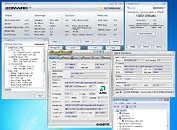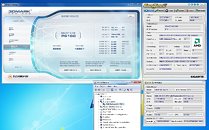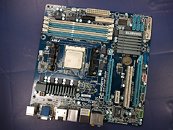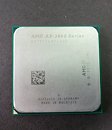Monday, June 13th 2011

AMD A-Series APU Smashes IGP Performance Records...Surprise
Armed with a Radeon HD 6550D graphics core that has 400 stream processors, 8 ROPs, and full DirectX 11 support, AMD A-Series "Llano" accelerated processing unit (APU) was tested to be the fastest integrated graphics solution to date. The tests was run by a forum-member of TweakTown community with early access to engineering samples. On the test-bed was AMD A8-3850 APU, which has four x86-64 cores clocked at 2.90 GHz, and the Radeon HD 6550D IGP with engine clock of 600 MHz. Standard dual-channel DDR3-1333 MHz memory was used, even though the APU supports faster DDR3-1866 MHz. To seat the test bed, Gigabyte A75M-UD2H was used. It's important to note here that the CPU cores were overclocked to 3.773 GHz (145.13 MHz x 26.0), with an insane core voltage of 1.52V.
The setup was put though three generations of 3DMark benchmark, covering DirectX 9.0c, DirectX 10, and DirectX 11 performance. In 3DMark 06, the setup scores 10,492 points. In 3DMark Vantage, it scored P6160 (performance preset, validation). In 3DMark 11, it scored P1591 (performance preset, validation). More details can be read in the screenshots.
Source:
TweakTown Forums
The setup was put though three generations of 3DMark benchmark, covering DirectX 9.0c, DirectX 10, and DirectX 11 performance. In 3DMark 06, the setup scores 10,492 points. In 3DMark Vantage, it scored P6160 (performance preset, validation). In 3DMark 11, it scored P1591 (performance preset, validation). More details can be read in the screenshots.





85 Comments on AMD A-Series APU Smashes IGP Performance Records...Surprise
TheMailMan78 saying something POSITIVE for once. The end is nigh puny mortals, for this is surely a sign of the Apocalypse.:eek:
but i have to say, im a bit suprised from the scores, they are even higher then i expected
AMD Phenom II 925 @ 2.8GHz = 95w.
AMD 890FX Northbridge Chipset = 18w.
AMD SB850 Southbridge Chipset = 4w.
Total = 152w.
AMD A8-3850 APU = 100w.
AMD Hudson D3 = ??w
Total = 1xx w.
many of desktop fusion processors tdp are stay at 65w.
and notbook part tdp is 35 - 45w.
And don't forget that fusion processors physical are smaller than PhenomII + First chipset + Second chipset + Graphic card + Video memory.
It's cut Graphic card, Videos memory and second chipset while performance still close neck to neck.
And today IGP is far slower than fusion graphics.
The only possible platform that closer in overall performance to Llano is Intel sandy bridge with HD 3000 graphics with some optimization.
Man I love it when these "I told you so" moments happen.
Increase cpu speed.
Keep gpu somwhat the same
My guess, just getting the gpu in was the hard part, but they have loads of shaderpower for an APU to be, just need tiny bit more clocks and memory bandwidth.
:)
ATI HD 5570 DDR5 default speed + i5 2500@3.3Ghz.
Source
But I wanna see someone put some DDR3-1866 CAS 6 on these desktop babies!
the IGP on the Fusion chip is roughly equal to 8800gt / 9800gt 4830 / 4850 / 4770
Roughly in 3dmark 06 the Fusion chip beats out most of the reviewed DX10 gpus
in 3dmark Vantage it proves its capable of matching said gpus as well when comparing gpu scores directly
www.bjorn3d.com/read.php?cID=1376&pageID=5538
from the looks this should greatly help in terms of the lowest common denominator in PC gaming, as it essentiall means anyone running an AMD fusion rig is getting a decent CPU + 8800gt performance.
THe below graphs are with said gpus + AMD X3 8750 triple core, so performance looks to be like having an athlon II series + 8800 or 4800 series gpu
i want one for my htpc
higher clocked 640+ shader cores discrete would definitely be faster than 400 shader core iGPU.
From graphs i looked at i can say that iGPU is around HD38(50/70) performance level(400 vs 320 cores, 600 vs 668/775 Mhz).Released in June, available in 1st half of July?
then again the CPU in the APU package is also much better then the Triple Core Phenom I based x3 8750, and since 3dmark tends to give the CPU more weight then games it could account for the difference but that said it wouldnt impact the GPU only scores and in those situations the GPU here compares favorable to older tech, but again were comparing 5 year old 8800 series vs IGP theres been advances in technology, simple shader vs shader doesnt really mean squat, as AMD changed the schedular and bunch of other aspects with the 6000 series architecture, and made tweaks. Granted we will have to wait for actual reviews but then again these dont scream fake either and no ones debunked them yet with simple logic. so Ill take it with a grain of salt and stand by my post that it brings the performance it should,
and for all the awesomeness of a 4850 its still only 25% faster then a 3870 while having double the specs so yea. care to elaborate why double the specs didnt double performance hmm?
From looks of the graph below the GPU in the APU is around 4830 performance well what do you know a 4830 is only around 10-12% better then a 3870 hmm all things considered this would appear to be believable, So yea comparing multi reviews around the web and those right here on TPU it would appear to me that the APU performs right where it should for the specs it has. granted it WILL lose at higher resolutions but im willing to bet at 1280x720 1280x1024 1440x900 this APU will be right at home.
The GPU must have been the hard part,because there is no L3 cache.
To me it seems like having two perfectly good baskets, and then placing all your eggs in one of them.
Even to OEMs.. does it matter if you have a CPU and a Graphics Card instead of a CPU that has a GPU inside of it?
It's actually worse, because the user would have to replace both the CPU and GPU if one of them died, since they are in the same package.
I think that instead of creating more powerful Integrated GPUs, for the "We don't know what a graphics card is" crowd..
You should educate people that a graphics card is better.
Will it run Crysis?
Everyone who is hating on it needs to remember that he was running lower speed RAM, and that bandwidth is shared with the GPU on the die, so as much as we need fast GDDR5 memory on newer cards to prevent idling, this needs it more as it is feeding four cores, and a GPU on relatively slow RAM.
And as mentioned above, the lack of cache on the chip means a huge performance penalty when either the CPU or GPU is demanding bandwidth. I'm sure with another die shrink or a respin they will find a way to add some dedicated or shared memory on die to improve performance.
This is exciting, I can see one of these running crossfire where the CPU/GPU runs physics and uses the actual processing capability of the system correctly, two of them and accelerated openCL video editing and you have a hell of a workstation. Or when they add them to the bulldozer even with minor gains in IPC if they can get openCL rolling......